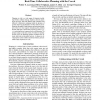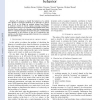510 search results - page 66 / 102 » Self-organizing logistics systems |
SASO
2008
IEEE
14 years 4 months ago
2008
IEEE
—When programming a spatial computing medium such as a cellular automaton, the hop count distance to some set of sources (particles) is an often used information. In particular, ...
SMC
2010
IEEE
13 years 8 months ago
2010
IEEE
—This paper presents a new framework to describe individual facial expression spaces, particularly addressing the dynamic diversity of facial expressions that appear as an exclam...
AAAI
2012
12 years 8 days ago
2012
Planning is vital to a wide range of domains, including robotics, military strategy, logistics, itinerary generation and more, that both humans and computers find difficult. Col...
IROS
2006
IEEE
14 years 3 months ago
2006
IEEE
— We propose to classify the behaviors of a mobile robot thanks to topological methods as an alternative to metric ones. To do so, we adapt an analysis scheme from Physics of non...
APNOMS
2006
Springer
14 years 1 months ago
2006
Springer
Peer-to-Peer systems are based on the concept of resources localization and mutualization in dynamic context. In specific environment such as mobile networks, characterized by high...


